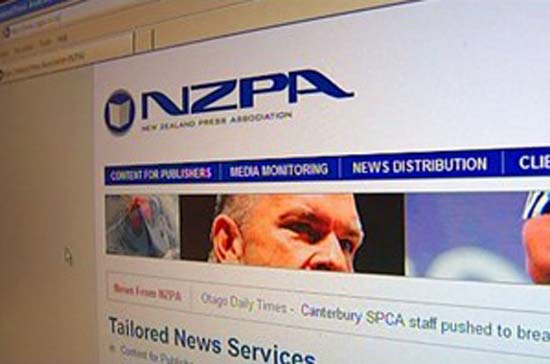
Fairfax New Zealand's announcement earlier this year that it is pulling out of the New Zealand Press Association has signed the death warrant of the 130-year-old news agency which it jointly owns with APN. New Zealand media commentator and former editor Karl du Fresne argues that the agency was effectively doomed from the moment it fell under Australian control.
OPINION: Even accepting that every institution has a natural lifespan, the impending demise (let’s call it euthanasia) of the New Zealand Press Association is unquestionably a setback for New Zealand journalism – and not just because 40-odd journalists will be put out of work, though I wouldn’t want to be thrown on the job market in the present economic climate.
Neither is the closure of NZPA simply a matter of sentimental regret, or even one that should be of concern only to journalists.
NZPA has fulfilled a historically significant role – one that remains valid even in the digital era. When it was launched in 1880, the agency had the effect of bringing New Zealand together. For the first time, via the telegraph, New Zealanders had ready access to news and information from beyond their own regions.
Historians have credited this with creating a sense of national cohesion in place of the narrow, regional parochialism that previously prevailed. At its peak, 74 member newspapers subscribed to the NZPA service, supplying the agency with stories from their own regions and in turn being provided with news of importance by other member papers.
It was a co-operative arrangement that worked well. It was especially important to smaller provincial papers with limited resources, which relied heavily on NZPA content to fill their pages each day; not so crucial to metropolitan papers with much bigger reporting staffs, such as the New Zealand Herald and the Christchurch Press.
NZPA provided the means by which readers in provincial centres such as Whangarei and Timaru could be informed of a murder trial in Invercargill or a plane crash on Mt Ruapehu.
The association supplemented this nuts-and-bolts news service by providing political coverage for smaller newspapers that couldn’t afford to maintain their own reporting staff in Parliament, and at its peak – in the 1960s and 70s – it had a network of overseas correspondents seeking out stories of significance to New Zealand from places like London, Washington and Hong Kong. In addition, NZPA served as a clearing house for international news sourced from agencies such as Reuters and AAP.
Family papers
One reason the co-operative model succeeded was that until the 1970s, the New Zealand newspaper industry consisted of a string of independent, mostly family-owned, papers, very few of which competed head-on with rivals in their own cities. They could afford to be magnanimous about providing news to papers in other regions that posed no direct threat.
But even after two big chains – INL and Wilson and Horton – came to dominate the industry through a series of mergers and takeovers in the 1970s and 80s, NZPA held together largely because the heads of those two groups, Mike Robson and Michael Horton, had grown up with the co-operative arrangements and understood their importance, especially to smaller papers. (The late Robson, who headed INL, was himself a former NZPA man.)
Competitive tensions often arose, particularly between Wellington’s Dominion and the Herald, whose circulation areas overlapped, but were generally resolved without blood being spilled.
All that changed when the two groups fell under Australian control. The co-operative model was alien to the modus operandi of Fairfax, which acquired INL, and APN, which took over Wilson and Horton. These two groups had a history of aggressive rivalry in Australia and couldn’t understand why they were expected to share news with each other. From the moment the Aussies found themselves in the unfamiliar position of sharing ownership of NZPA, the agency was on a slippery slope.
In fact NZPA came perilously close to collapse as early as 2004, when Fairfax threatened to withdraw from the agency after APN launched its Herald on Sunday in opposition to Fairfax’s Sunday Star Times and Sunday News. NZPA survived only by undergoing a radical restructuring that involved abandoning the co-operative model and reconstituting itself as a wholly commercial, stand-alone service
Under these arrangements, effective from January 2006, member papers no longer fed news to the agency. Instead NZPA generated news using its own staff and a network of part-time correspondents scattered around the country. Revenue was generated on a user-pays basis rather than by the traditional arrangements whereby NZPA was funded by subscriptions paid by member papers.
One immediate effect was that NZPA went from effectively having several hundred reporters in newspaper offices around the country to being reliant on a few dozen of its own staff, mostly based in Wellington, augmented by the part-time stringers. Though it signalled the end of NZPA’s golden era, the restructuring at least bought a stay of execution. And in hindsight, that’s all what it was; because as radical as the 2006 upheaval was, it probably succeeded only in postponing the inevitable. NZPA now seems to have been doomed from the moment the Australians took control.
Key consequences
So what are the consequences likely to be? First, it will hurt APN more than it hurts Fairfax. This no doubt helps explain why Fairfax, not APN, ultimately pulled the plug (and why APN, according to chief operating officer Rick Neville, fought to keep NZPA going).
Fairfax has a substantial competitive advantage over its rival because it controls a much bigger part of the country. Auckland is APN’s citadel, thanks to the overwhelming dominance of the Herald in New Zealand’s biggest city, but nationally Fairfax is the bigger player, controlling most of the lower North Island – including Wellington – and virtually the entire South Island. Its geographical spread means Fairfax has been able to develop an in-house news-sharing network that almost rivals that of the old NZPA.
Former NZPA editor John Crowley has been busy behind the scenes at Fairfax for the past several years, presumably doing just that. Fairfax New Zealand executive editor Paul Thompson promises more “compelling, exclusive” content than that provided by the national agency.
APN is much less favourably placed and will struggle to match Fairfax for coverage. The company is establishing its own agency, using its own staff and drawing on connections with a handful of remaining independent papers, including Dunedin’s Otago Daily Times, but it has a lot of ground to make up. Seen in that light, the impending closure of NZPA can be interpreted as Fairfax exploiting its geographical supremacy and putting its foot on the throat of its long-time rival.
And what of the wider consequences? One will be that NZPA’s non-newspaper clients – which include radio and TV – will lose a valuable source of news. But far more important will be the impact on newspaper readers.
Former Herald editor-in-chief Gavin Ellis, who completed a master’s degree thesis on the consequences of NZPA’s 2006 restructuring, laments that newspapers will no longer have access to NZPA’s political coverage. This will be a loss because NZPA staff covered the daily nuts-and-bolts of politics – such as select committee hearings and parliamentary debates – that the major papers had long since lost interest in.
Even more worrying is that the existing “black holes” in news coverage will become wider and blacker still. Under the old co-operative model, NZPA had the entire country covered (though some papers were conspicuously less conscientious than others about meeting their obligations to the agency). The black holes started to become evident after 2006, when NZPA’s traditional sources dried up and the flow of news from the regions slowed to a trickle.
Invisible areas
The gaps will become even more obvious once NZPA passes into extinction.
Fairfax papers can be expected to carry news from regions where Fairfax holds sway, but what about those parts of the country where it has no presence? More to the point, how will APN papers get news from the vast swathes of territory where APN is unrepresented? Doubtless they will do what they can, particularly when big stories break. But the service will be no substitute for the comprehensive, day-to-day coverage once provided by NZPA.
The net result is that New Zealanders will know less about themselves. Parts of the country that have already faded from view since 2006 because of attenuated news coverage may become damned-near invisible, other than when a catastrophe occurs (as at Pike River, where 29 miners died in an explosion last year).
In hard-nosed business terms, Fairfax’s withdrawal from NZPA makes perfect sense. But from a wider public interest perspective, and even allowing that the real damage to NZPA was done in 2006, it’s hard to see it as anything other than a retrograde step. If the creation of NZPA in 1880 helped tie the country together, then its demise is likely to have the reverse effect.
Karl du Fresne is a freelance journalist, columnist and former editor of the Wellington daily The Dominion. A version of this commentary originally appeared on his blog and this version was first published in the May/June edition of the Walkley Magazine and has been republished here with permission of the author.



